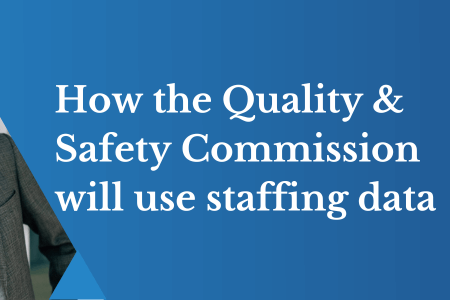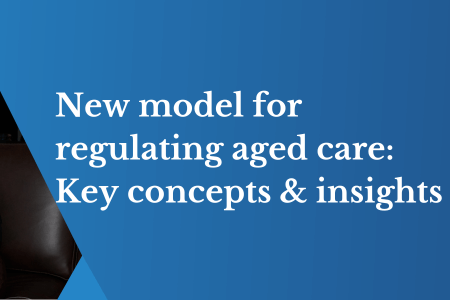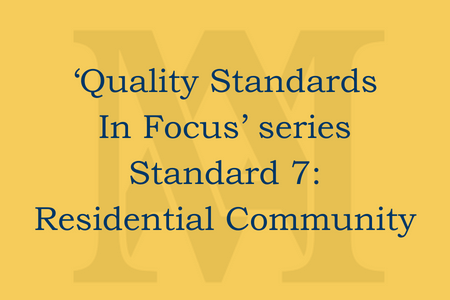The new Aged Care Quality Standards – Standard 2: The Organisation
November 28, 2022 | Quality

By Katie Airey, Quality, Risk and Compliance Lead
As part of the Aged Care reform, the Department of Health and Aged Care (DoHAC) are undertaking a review of the Quality Standards. On the 26th October 2022 the DoHAC held a focus group to seek feedback on the draft Quality Standards – Standard 2: The Organisation from consumers, aged care providers and workers.
Standard 2: The Organisation
The draft Standard 2 draws on elements of Standards 6 – Feedback & Complaints, Standard 7 – Human Resources and Standard 8 – Organisational Governance of the current Quality Standards
The intention of Standard 2 – The Organisation, is to hold the governing body responsible for meeting the requirements of the Quality Standards in delivering safe and quality care and services to older people.
Similar to the current Quality Standards, Standard 1 of the draft Quality Standards underpins how providers and their workforce treat older people who they provide care and services to.
The Standard retains many of the current concepts including;
- Complaints management
- Human resources
- Incident management
And aims to strengthen the focus on the below areas;
- Partnering with older people to inform care and services – Providers must directly engage with older people in meaningful and active partnerships to govern, plan and evaluate organisational improvements
- Quality and safety culture – The governing body of the organisation must lead and facilitate a culture that is focused on continuous improvement, safety and embraces diversity while also priorities the rights and wellbeing of older people and their workforce.
- Accountability and quality systems – The governing body is ultimately responsible for the delivery of quality care and services. The provider must implement a quality system that monitors, analysis, improves and evaluates systems and processes for effectiveness in the organisation for the purpose of continuous improvement.
- Workforce planning – Providers must understand their workforce, including challenges of shortages and plan to mitigate associated risks. This includes understanding workforce skills mix and undertaking assessment to determine workforce performance, in order to provide safe, quality care and services by a workforce who are suitably skilled and competent.
- Emergency and disaster management – The provider needs to consider emergency and disaster management plans to mitigate risks to the wellbeing, health and safety of their workforce and older people who they care for. Provider must engage with their workforce, older people and their families about their emergency and disaster management plans.
Providers should already have systems and processes in place to manage organisational governance. However, the new draft Quality Standards will have a heightened focus on requiring providers to implement robust governance and quality systems and practices.
Standard 2 – Overview
Expectation statement for older people
The organisation is well run. I can contribute to improvements to care and services. My provider and workers listen and respond to my feedback and concerns. I receive care and services from workers who are knowledgeable, competent, capable and caring.
Outcomes Statements:
2.1: Partnering with older people
Meaningful and active partnerships with older people inform organisational priorities and improvements to care and services.
2.2: Quality and safety culture
The governing body leads a culture of quality, safety and inclusion that embraces diversity and prioritises the rights, safety and well-being of older people and the workforce.
2.3: Accountability and quality systems
The governing body is accountable for the delivery of safe and quality care and services and maintains oversight of all aspects of the organisation’s operations. The provider’s quality system supports continuous improvement.
2.4: Risk Management
Risks to older people, workers and the organisation are identified, managed and continuously reviewed.
2.5: Incident management
The provider uses an incident management system to safeguard older people and acknowledge, respond to, effectively manage and learn from incidents.
2.6: Feedback and complaints management
Older people and others are encouraged and supported to provide feedback and make complaints about care and services. Feedback and complaints made by all parties are acknowledged, managed transparently and contribute to the continuous improvement of care and services. Older people and others can complain without reprisal.
2.7: Information management
Information is identifiable, accurately recorded, current and able to be accessed and understood by those who need it. The information of older people is confidential and managed appropriately, in line with their consent. Current policies and procedures guide the way workers undertake their roles.
2.8: Workforce planning
The provider understands and manages its workforce needs and plans for the future.
2.9: Human resource management
The care and service needs of older people are met by workers who are skilled and competent in their role, hold relevant qualifications and who have relevant expertise and experience to provide safe and quality care and services.
2.10: Emergency and disaster management
Emergency and disaster management considers and manages the risks to the health, safety and wellbeing of older people and workers.
For more details on the draft Quality Standards click here
The Aged Care commission will conduct a pilot to test the redesigned audit methodology for assessing providers against the revised Quality Standards, this is expected to occur early in 2023.
Further information will be made available on the Aged Care Commissions website.
Want to test your organisations processes?


